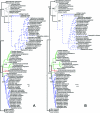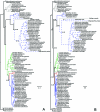Fusion of the subunits α and β of succinyl-CoA synthetase as a phylogenetic marker for Pezizomycotina fungi
- PMID: 22215972
- PMCID: PMC3229123
- DOI: 10.1590/S1415-47572011005000040
Fusion of the subunits α and β of succinyl-CoA synthetase as a phylogenetic marker for Pezizomycotina fungi
Abstract
Gene fusions, yielding the formation of multidomain proteins, are evolutionary events that can be utilized as phylogenetic markers. Here we describe a fusion gene comprising the α and β subunits of succinyl-coA synthetase, an enzyme of the TCA cycle, in Pezizomycotina fungi. This fusion is present in all Pezizomycotina with complete genome sequences and absent from all other organisms. Phylogenetic analysis of the α and β subunits of succinyl-CoA synthetase suggests that both subunits were duplicated and retained in Pezizomycotina while one copy was lost from other fungi. One of the duplicated copies was then fused in Pezizomycotina. Our results suggest that the fusion of the α and β subunits of succinyl-CoA synthetase can be used as a molecular marker for membership in the Pezizomycotina subphylum. If a species has the fusion it can be reliably classified as Pezizomycotina, while the absence of the fusion is suggestive that the species is not a member of this subphylum.
Keywords: evolutionary marker; fungi phylogeny; fused genes.
Figures


Similar articles
-
New insights into the evolution of subtilisin-like serine protease genes in Pezizomycotina.BMC Evol Biol. 2010 Mar 9;10:68. doi: 10.1186/1471-2148-10-68. BMC Evol Biol. 2010. PMID: 20211028 Free PMC article.
-
scsB, a cDNA encoding the hydrogenosomal beta subunit of succinyl-CoA synthetase from the anaerobic fungus Neocallimastix frontalis.Mol Gen Genet. 1996 Dec 13;253(3):315-23. doi: 10.1007/pl00008598. Mol Gen Genet. 1996. PMID: 9003318
-
Molecular evolution of urea amidolyase and urea carboxylase in fungi.BMC Evol Biol. 2011 Mar 29;11:80. doi: 10.1186/1471-2148-11-80. BMC Evol Biol. 2011. PMID: 21447149 Free PMC article.
-
The subunits of succinyl-coenzyme A synthetase--function and assembly.Biochem Soc Symp. 1987;54:103-11. Biochem Soc Symp. 1987. PMID: 3332988 Review.
-
Protein signatures distinctive of alpha proteobacteria and its subgroups and a model for alpha-proteobacterial evolution.Crit Rev Microbiol. 2005;31(2):101-35. doi: 10.1080/10408410590922393. Crit Rev Microbiol. 2005. PMID: 15986834 Review.
Cited by
-
Beyond mitochondria: Alternative energy-producing pathways from all strata of life.Metabolism. 2021 May;118:154733. doi: 10.1016/j.metabol.2021.154733. Epub 2021 Feb 23. Metabolism. 2021. PMID: 33631145 Free PMC article. Review.
References
-
- Abascal F, Zardoya R, Posada D. ProtTest: Selection of best-fit models of protein evolution. Bioinformatics. 2005;21:2104–2105. - PubMed
-
- Alexopoulos CJ, Mims CW, Blackwell M. Introductory Mycology. 4th edition. John Wiley & Sons; New York: 1996. p. 880.
-
- Anisimova M, Gascuel O. Approximate likelihood ratio test for branchs: A fast, accurate and powerful alternative. Syst Biol. 2006;55:539–552. - PubMed
-
- Birney MA, Klein C. Cloning and expression of the α subunit of succinyl-CoA synthetase from Dictyostelium discoideum. Arch Biochem Biophys. 1995;319:93–101. - PubMed
Internet Resources
-
- Fungi genome BLAST tool. http://www.ncbi.nlm.nih.gov/sutils/genom_table.cgi?organism=fungi(August 2009)
-
- FigTree Software. http://tree.bio.ed.ac.uk/software/figtree/(July 2010)
-
- Postia placenta genome page at Joint Genome Institute (JGI) http://genomeportal.jgi-psf.org/Pospl1/Pospl1.home.html(June 2010)
-
- Aspergillus niger genome page at Joint Genome Institute (JGI) http://genome.jgi-psf.org/Aspni5/Aspni5.home.html(June 2010)
LinkOut - more resources
Full Text Sources

